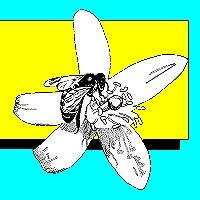APIS Volume 9, Number 9, September 1991

In this issue
- African Bee Alternatives
- National Honey Board's "Just Add Honey"
AFRICAN BEE ALTERNATIVES
At a recent meeting of the Tampa Bay Beekeepers Association, there were a lot of glum faces. These were caused by a discussion of what many beekeepers will be faced with when the African honey bee arrives. The participants at that meeting urged me to write something that would be upbeat and positive about this overdefensive insect. This is a tall order.
Chance will play a big role in how the situation surrounding the African honey bee develops. This is why prognostications by experts may or may not have validity. There are many ifs (unknowns) in the African bee equation and they will change as the situation evolves. On top of this is the fact that the bee itself is variable and may behave in an unpredictable manner further complicating the issue.
As I wrote in an article in the December, 1989 APIS, much will depend on whether beekeepers perceive the apicultural cup as half empty or half full when the bee arrives. In Latin America, for example, the proliferation of wild African bees now means a free resource (wild swarms and nests) is available which was not the case before. This may also be true in subtropical Florida. However, the public relations aspects of keeping wild bees will be significantly different than in most of Latin America.
Alternatives that some beekeepers might look to in the face of a wild honey bee population concern removing the insects from sensitive areas. Beyond marketing such services in urban areas (removing bees from houses), a trapping technology exists which can be marketed to large firms. Maintaining and running bee trap lines around the many theme parks of Florida come to mind. This has been done in industrial parks in Brazil with some success. Consulting in the training of fire, police and others who will be called by the public to remove nuisance bees is also a possibility. This will require some rethinking and retooling of skills. The beekeeper-would- be-bee-remover might have to adhere to rules of the professional pest control operator. Most present pest control operations avoid honey bee jobs because they can be so complicated; this leaves the field open to a specialist beekeeper.
Those who wish to continue keeping bees as usual will also have to rethink many aspects of their activities. The successful beekeeper of the future may in fact be more of a public relations expert. The message that will have to be drilled into the public's head is that managed colonies of docile honey bees will be the first line of defense against the wild, overdefensive African kind. This will mean a constant job of educating neighbors and public officials about the value of keeping bees in urban and rural areas to compete with wild populations. Part of this effort could well be to make one's services as a bee consultant available to public officials who will need good advice about matters involving nuisance colonies and swarms. Here you could become assertive, wearing a white hat by taking the lead in community efforts to control "unwanted" bees.
The latter practice was advocated in an article entitled, "Civil Obedience," in the July issue of Gleanings in Bee Culture. It suggests that if a community does not have an ordinance dealing with honey bees, local beekeepers should help draft one. This is a two-edged sword and must be approached carefully, however, if the strategy is to be successful and not backfire. The article, along with a copy of a model ordinance developed for Texas, is available by sending a stamped, self-addressed envelope to Ordinance, P.O. Box 706, Medina, OH 44256.
Another "proactive" strategy the industry as a whole can consider is developing a Code of Practice. This is true in other areas of the world as well. According to the June, 1991 issue of Buzzwords, the newsletter of the New Zealand National Beekeepers Association, an important reason for contemplating a code of practice is that some beekeepers are reporting difficulties with local government. Some councils, the newsletter continues, are charging license fees of NZ $35.00 per hive (and no disease inspection, thank you) while in town. Local authority inspectors are rumored to be using the public nuisance by-law to remove all beehives located within municipal boundaries. A code of practice is seen as an effective counter to such problems, because councils tend to use them as the basis for local body legislation. The article concludes: "The question your executive is asking, however, is what should be included in such a code."
In an effort to find out what a U.S. code might include, groups have met and documents have been published. A significant event will occur October 24-26 in St. Louis, Missouri. USDA and the National Association of State Departments of Agriculture (NASDA) will meet along with industry representatives to hammer out guidelines for a model honey bee certification plan. One basis for this is a document published last February entitled: Honey Bee Pests-- A Threat to the Vitality of U.S. Agriculture, subtitled, A National Strategy. Another document published by the Apiary Inspectors of America, A National Honey Bee Certification Proposal, will also be discussed in St. Louis.
REMEMBER SEPTEMBER
Remember that September is National Honey Month. A line of distinctive advertising items is available from the National Honey Board to keep your customers coming back for more. These include recipes, brochures, clip art and the new cooking video, "Just Add Honey." For more information, contact the Board, 421 21st Ave. #203, Longmont, CO 80501-1421, ph 303/776-1177.
Malcolm T. Sanford
Bldg 970, Box 110620
University of Florida
Gainesville, FL 32611-0620
Phone (904) 392-1801, Ext. 143 FAX: 904-392-0190
http://www.ifas.ufl.edu/~entweb/apis/apis.htm
INTERNET Address: MTS@GNV.IFAS.UFL.EDU
©1991 M.T. Sanford "All Rights Reserved
















